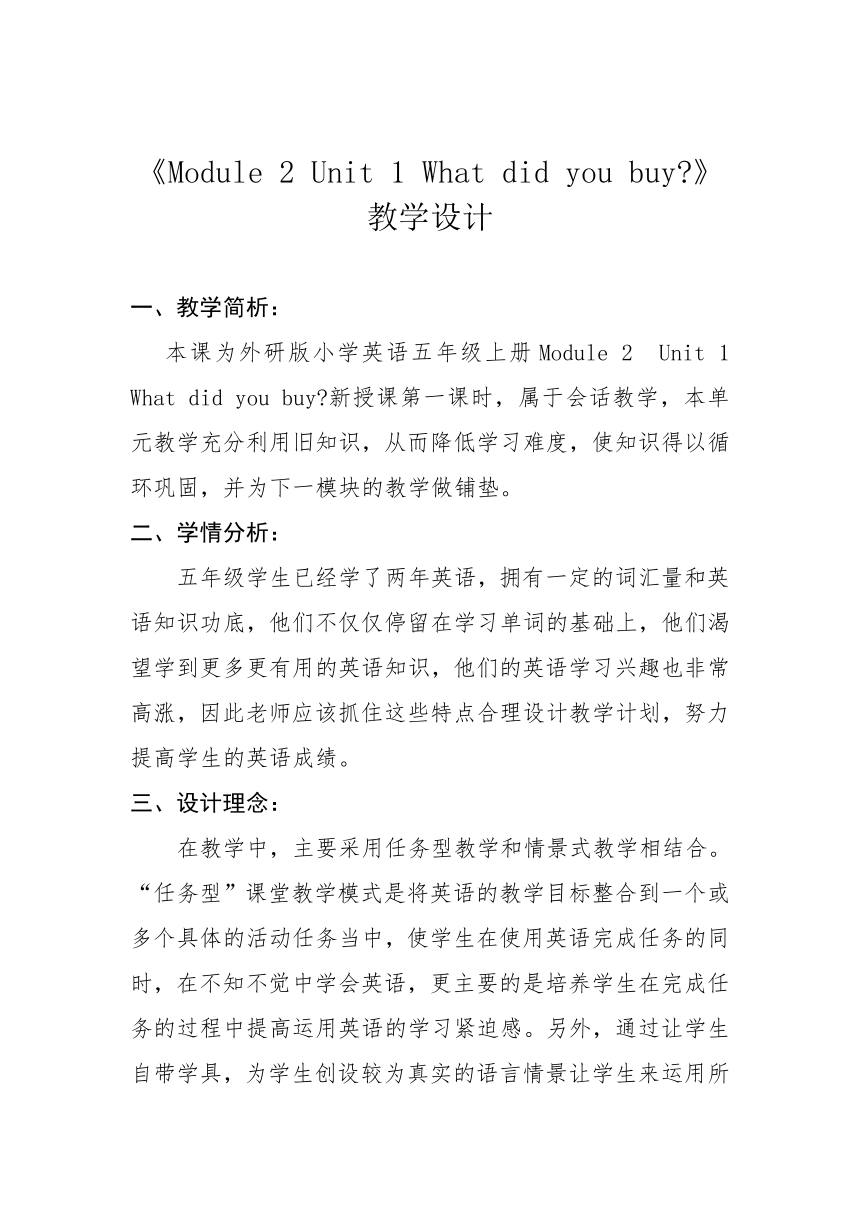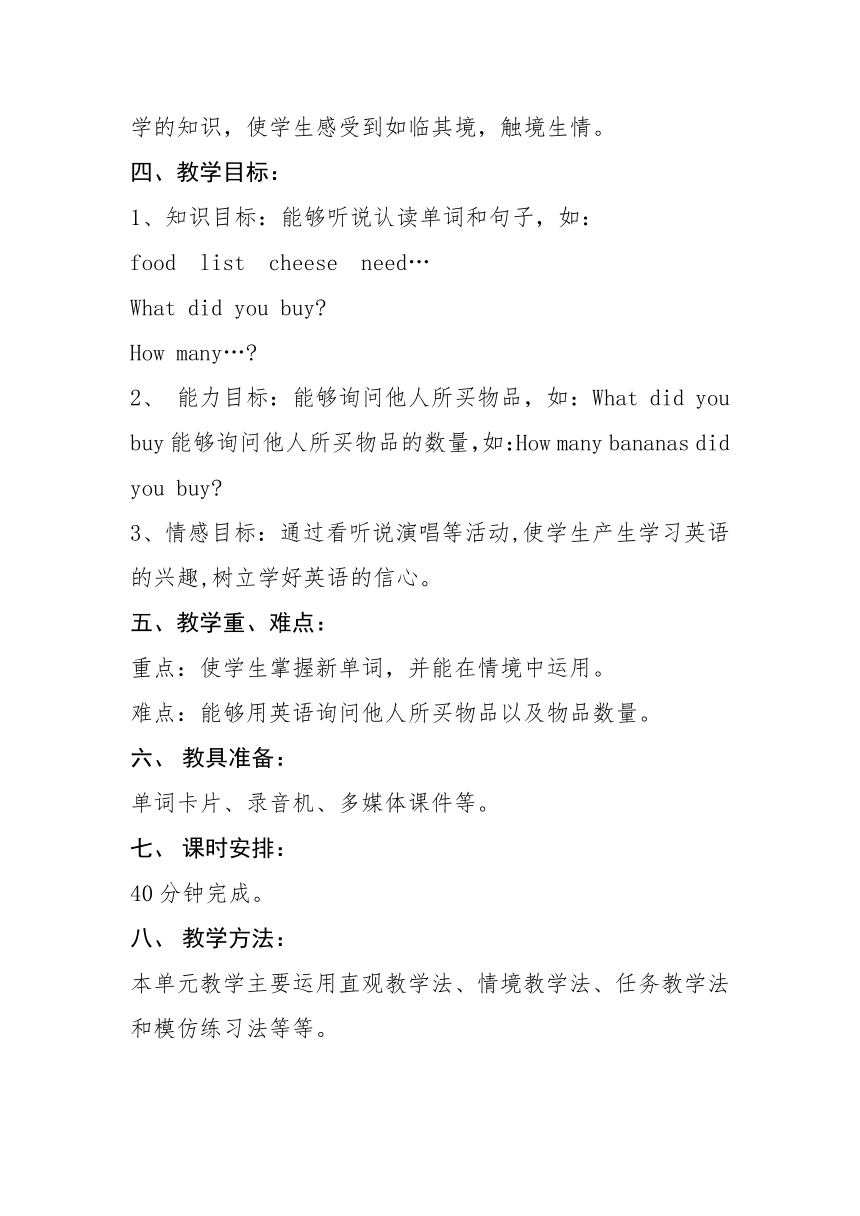Module 2 Unit 1 What did you buy教案
文档属性
| 名称 | Module 2 Unit 1 What did you buy教案 |  | |
| 格式 | doc | ||
| 文件大小 | 30.5KB | ||
| 资源类型 | 教案 | ||
| 版本资源 | 外研版(三年级起点) | ||
| 科目 | 英语 | ||
| 更新时间 | 2023-11-24 07:46:53 | ||
图片预览



文档简介
《Module 2 Unit 1 What did you buy 》教学设计
一、教学简析:
本课为外研版小学英语五年级上册Module 2 Unit 1 What did you buy 新授课第一课时,属于会话教学,本单元教学充分利用旧知识,从而降低学习难度,使知识得以循环巩固,并为下一模块的教学做铺垫。
二、学情分析:
五年级学生已经学了两年英语,拥有一定的词汇量和英语知识功底,他们不仅仅停留在学习单词的基础上,他们渴望学到更多更有用的英语知识,他们的英语学习兴趣也非常高涨,因此老师应该抓住这些特点合理设计教学计划,努力提高学生的英语成绩。
三、设计理念:
在教学中,主要采用任务型教学和情景式教学相结合。“任务型”课堂教学模式是将英语的教学目标整合到一个或多个具体的活动任务当中,使学生在使用英语完成任务的同时,在不知不觉中学会英语,更主要的是培养学生在完成任务的过程中提高运用英语的学习紧迫感。另外,通过让学生自带学具,为学生创设较为真实的语言情景让学生来运用所学的知识,使学生感受到如临其境,触境生情。
四、教学目标:
1、知识目标:能够听说认读单词和句子,如:
food list cheese need…
What did you buy
How many…
2、 能力目标:能够询问他人所买物品,如:What did you buy能够询问他人所买物品的数量,如:How many bananas did you buy
3、情感目标:通过看听说演唱等活动,使学生产生学习英语的兴趣,树立学好英语的信心。
五、教学重、难点:
重点:使学生掌握新单词,并能在情境中运用。
难点:能够用英语询问他人所买物品以及物品数量。
教具准备:
单词卡片、录音机、多媒体课件等。
课时安排:
40分钟完成。
教学方法:
本单元教学主要运用直观教学法、情境教学法、任务教学法和模仿练习法等等。
教学过程:
Step 1 Warm-up(热身导入)
课前歌曲(Fruit)
Greeting:
T:Good morning, boys and girls!
Ss: Good morning, teacher!
T: How are you
Ss: Fine, and you
T: I’m fine. Now let’s listen to a song and then sing it together, ok
Ss: OK!
齐听、唱歌曲(Fruit)
(设计意图:活跃课堂气氛,创设英语氛围,激发学生的学习兴趣)
Step 2 Presentation:(知识呈现)
教学新单词
通过出示Mr Smart和Sam对话的模拟情景,引出新单词:list food cheese
(1)出示单词list并领读指读
T:If you want go shopping.You can make a shopping list.
紧接延伸: Such as: name list名单; book list书本目录.
(2)出示单词cheese并领读指读
T:Read together.bananas,apples,pears,and cheese.
(3)(指着模拟超市说)At the supermarket.We have some apples,bananas,(出示这些食物课件)noodles,meat。All these are food.
出示food单词并领读指读
齐读所学单词
(设计意图:认识新单词,使学生准确理解课文内容,减少阅读困难)
教学新句型
(1)(教师指着模拟超市)
T: Look! There are some apples. How many Lets count.(One…)
T: Do you like apples
S1: Yes,I do.
T: What did you buy
S1: Apples.
(2) 出示句型What did you buy (你买了什么?)
领读指读,并讲解
—What did you buy
—We bought some apples.
(3)点名学生两两一组,进行造句(一问一答)
如: S1: What did you buy
S2: We bought some bananas.
(设计意图:通过真实的情景导入重点句型学习,避免了枯燥,无味的方式。同时进行分组练习,进一步巩固了句型练习)
3、课文学习
Activity 1 Look,listen and say.
活动1 看一看,听一听,说一说
T: Today, Ms Smart and Amy go shopping.
Let’s listen to Ms Smart and Amy: How do they go shopping.
(1)First, Look listen and learn.
(2)Second. Look listen and say.
(3)(质疑)Can you read the shopping list to me I don’t know the Chinese meaning. Who can tell me
(4)Now read in pairs. One is Ms Smart. One is Lingling.(小组分角色朗读)
Activity 2 Listen, read and act out.
活动2 听一听,读一读,并表演
At home情景模拟:
(1)Mr. Smart. Ms Smart and Amy(教师与两名同学演示)
(2)请几组到前面表演
(3)训练句型:How many bananas did you buy —Ten.
“how many” 和“how much” 都是用来询问“多少”的。但是,“how many”用来提问可数物品名词的数量,而“how much”用来提问不可数物品名词的数量。
Next. Let’s have a try.(选择正确答案)
(1)选出与购物有关的句子:
A: Have you got a toy car B: What do you do at the weekend
C: Yesterday, I went shopping. D: I live in West Lake Road.
(2)选出你喜欢的食物:
A: car ship doll plane kite B: cat dog tiger lion elephant
C: shopping need like want D: cheese juice orange bananas
(设计意图:以表演的形式,让学生学以致用,将课堂上的知识与生活实际相联系,培养了学生对语言的综合运用能力。)
Step 3 Practice and consolidation(练习与巩固)
分组运用句型What did you buy 和How many …did you buy 等进行模拟情境对话。
(设计意图:进一步地巩固本单元的重点句型)
Step 4 Conclusion(课堂小结)
新单词:food cheese list …
新句型:What did you buy
How many …did you buy
Step 5: Homework(课后作业)
1.听录音,朗读课文并试着录音
2.与家人到超市或文具商场进行英语购物对话文章
十、 Blackboard design(板书设计)
Module2 Unit1 What did you buy
a shopping list food cheese how much(不可数) how many(可数)
—What did you buy
—I bought some apples.
—How many did you buy
—I bought ten apples.
—How much did you buy
—I bought some cheese.
一、教学简析:
本课为外研版小学英语五年级上册Module 2 Unit 1 What did you buy 新授课第一课时,属于会话教学,本单元教学充分利用旧知识,从而降低学习难度,使知识得以循环巩固,并为下一模块的教学做铺垫。
二、学情分析:
五年级学生已经学了两年英语,拥有一定的词汇量和英语知识功底,他们不仅仅停留在学习单词的基础上,他们渴望学到更多更有用的英语知识,他们的英语学习兴趣也非常高涨,因此老师应该抓住这些特点合理设计教学计划,努力提高学生的英语成绩。
三、设计理念:
在教学中,主要采用任务型教学和情景式教学相结合。“任务型”课堂教学模式是将英语的教学目标整合到一个或多个具体的活动任务当中,使学生在使用英语完成任务的同时,在不知不觉中学会英语,更主要的是培养学生在完成任务的过程中提高运用英语的学习紧迫感。另外,通过让学生自带学具,为学生创设较为真实的语言情景让学生来运用所学的知识,使学生感受到如临其境,触境生情。
四、教学目标:
1、知识目标:能够听说认读单词和句子,如:
food list cheese need…
What did you buy
How many…
2、 能力目标:能够询问他人所买物品,如:What did you buy能够询问他人所买物品的数量,如:How many bananas did you buy
3、情感目标:通过看听说演唱等活动,使学生产生学习英语的兴趣,树立学好英语的信心。
五、教学重、难点:
重点:使学生掌握新单词,并能在情境中运用。
难点:能够用英语询问他人所买物品以及物品数量。
教具准备:
单词卡片、录音机、多媒体课件等。
课时安排:
40分钟完成。
教学方法:
本单元教学主要运用直观教学法、情境教学法、任务教学法和模仿练习法等等。
教学过程:
Step 1 Warm-up(热身导入)
课前歌曲(Fruit)
Greeting:
T:Good morning, boys and girls!
Ss: Good morning, teacher!
T: How are you
Ss: Fine, and you
T: I’m fine. Now let’s listen to a song and then sing it together, ok
Ss: OK!
齐听、唱歌曲(Fruit)
(设计意图:活跃课堂气氛,创设英语氛围,激发学生的学习兴趣)
Step 2 Presentation:(知识呈现)
教学新单词
通过出示Mr Smart和Sam对话的模拟情景,引出新单词:list food cheese
(1)出示单词list并领读指读
T:If you want go shopping.You can make a shopping list.
紧接延伸: Such as: name list名单; book list书本目录.
(2)出示单词cheese并领读指读
T:Read together.bananas,apples,pears,and cheese.
(3)(指着模拟超市说)At the supermarket.We have some apples,bananas,(出示这些食物课件)noodles,meat。All these are food.
出示food单词并领读指读
齐读所学单词
(设计意图:认识新单词,使学生准确理解课文内容,减少阅读困难)
教学新句型
(1)(教师指着模拟超市)
T: Look! There are some apples. How many Lets count.(One…)
T: Do you like apples
S1: Yes,I do.
T: What did you buy
S1: Apples.
(2) 出示句型What did you buy (你买了什么?)
领读指读,并讲解
—What did you buy
—We bought some apples.
(3)点名学生两两一组,进行造句(一问一答)
如: S1: What did you buy
S2: We bought some bananas.
(设计意图:通过真实的情景导入重点句型学习,避免了枯燥,无味的方式。同时进行分组练习,进一步巩固了句型练习)
3、课文学习
Activity 1 Look,listen and say.
活动1 看一看,听一听,说一说
T: Today, Ms Smart and Amy go shopping.
Let’s listen to Ms Smart and Amy: How do they go shopping.
(1)First, Look listen and learn.
(2)Second. Look listen and say.
(3)(质疑)Can you read the shopping list to me I don’t know the Chinese meaning. Who can tell me
(4)Now read in pairs. One is Ms Smart. One is Lingling.(小组分角色朗读)
Activity 2 Listen, read and act out.
活动2 听一听,读一读,并表演
At home情景模拟:
(1)Mr. Smart. Ms Smart and Amy(教师与两名同学演示)
(2)请几组到前面表演
(3)训练句型:How many bananas did you buy —Ten.
“how many” 和“how much” 都是用来询问“多少”的。但是,“how many”用来提问可数物品名词的数量,而“how much”用来提问不可数物品名词的数量。
Next. Let’s have a try.(选择正确答案)
(1)选出与购物有关的句子:
A: Have you got a toy car B: What do you do at the weekend
C: Yesterday, I went shopping. D: I live in West Lake Road.
(2)选出你喜欢的食物:
A: car ship doll plane kite B: cat dog tiger lion elephant
C: shopping need like want D: cheese juice orange bananas
(设计意图:以表演的形式,让学生学以致用,将课堂上的知识与生活实际相联系,培养了学生对语言的综合运用能力。)
Step 3 Practice and consolidation(练习与巩固)
分组运用句型What did you buy 和How many …did you buy 等进行模拟情境对话。
(设计意图:进一步地巩固本单元的重点句型)
Step 4 Conclusion(课堂小结)
新单词:food cheese list …
新句型:What did you buy
How many …did you buy
Step 5: Homework(课后作业)
1.听录音,朗读课文并试着录音
2.与家人到超市或文具商场进行英语购物对话文章
十、 Blackboard design(板书设计)
Module2 Unit1 What did you buy
a shopping list food cheese how much(不可数) how many(可数)
—What did you buy
—I bought some apples.
—How many did you buy
—I bought ten apples.
—How much did you buy
—I bought some cheese.
同课章节目录
- Module 1
- Unit 1 Did you come back yesterday?
- Unit 2 We bought ice creams.
- Module 2
- Unit 1 What did you buy?
- Unit 2 How much cheese did you buy?
- Module 3
- Unit 1 Where did you go?
- Unit 2 Daming took a photo of his father.
- Module 4
- Unit 1 Mum bought a new T-shirt for me.
- Unit 2 What's the matter with Daming?
- Module 5
- Unit 1 There are only nineteen crayons
- Unit 2 There are forty.
- Module 6
- Unit 1 You can play football well.
- Unit 2 He ran very fast.
- Module 7
- Unit 1 He can't see.
- Unit 2 This little girl can't walk.
- Module 8
- Unit 1 What time does your school start?
- Unit 2 Yesterday I went to Sam and Amy's school.
- Module 9
- Unit 1 Are you feeling bored?
- Unit 2 I feel happy.
- Review Module
- Unit 1
- Unit 2
- Module 10
- Unit 1 He was in the kitchen.
- Unit 2 Don't shout, please!
- 旧版资料
- Module 1 London
- Module 2 Shopping
- Module 3 At the Weekend
- Module 4 Possession
- Module 5 In Class
- Module 6 Self-assessment
- Module 7 Community
- Module 8 School
- Module 9 Feelings
- Module 10 Manners
- Review Module
